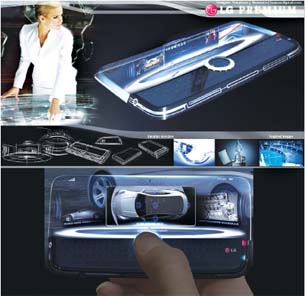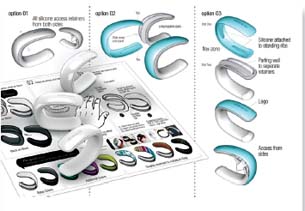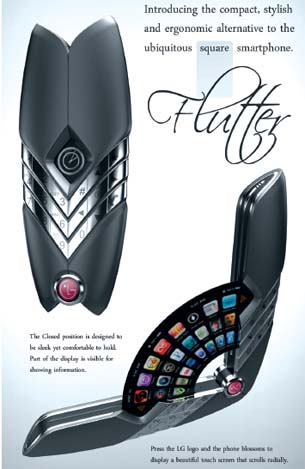February 1, 2011
By Mark Clarkson
 The Premium concept phone took second place at LG’s 2010 Design the Future competition. It was one of more than 1,000 entries. |
Let’s say your local college basketball team wants to create new T-shirts to sell to fans, alumni and other boosters. The team announces a competition for the new design. Interested parties submit their designs, and those designs are published on the school’s website, where anyone can vote on them. The design that garners the most votes is printed on the new T-shirts.
That’s crowdsourcing: leveraging the power of the crowd to do all the heavy lifting. The crowd creates the designs, votes on the designs and, ultimately, buys the T-shirts. All the school has to do is post the entries and track the votes.
The idea is actually pretty old. There have always been contests, competitions and scholarships. The logo of Italian petroleum company AGIP (now ENI) — a six-legged, fire-breathing dog — was the result of a popular competition way back in 1952 that pulled in around 4,000 entries.
Crowdsourcing, though, has been greatly facilitated by the Internet. It is turning from an occasional lark to a viable business model for an ever-expanding range of businesses.
Internet T-shirt retailer Threadless, for example, has been very successful with the above-described business model: Anyone can submit and vote on T-shirt designs. The most popular designs are produced as shirts for sale on the site.
Up until now, crowdsourcing has largely been restricted the domain of graphic design: logos, T-shirts, CD covers, websites, etc. In fact, that’s still the vast majority of crowdsourcing projects. But that’s beginning to change.
From Crowds to CAD
Consider crowdsourcing giant crowdSPRING, which averages approximately 225 open projects at any given time. It boasts a community of more than 75,000 designers, photographers and writers from 185 countries. crowdSPRING started with graphics projects, but has since added photography, writing and, yes, industrial design.
 Winning concept for the Embracer Sportband Project. |
The site has hosted product design projects for everything from pasta shapes to adult toys (the former was just looking for drawings; the latter required 3D CAD files.) At press time, a project to design innovative concepts for steam irons, posted by Royal Philips Electronics, is just wrapping up. First place pays $4,500 plus a copy of Autodesk Alias Design.
“Industrial design works beautifully for crowdsourcing,” says crowdSPRING’s co-founder, Mike Samson. “In fact, we believe that the model works well for many kinds of creative services — as long as they meet a couple of basic criteria. If the design can be delivered digitally, crowdsourcing works. And as long as you can effectively compare two entries side-by-side, crowdsourcing works.”
So a simple piece of writing — this article, for example — is entirely crowdsource-compatible. Translating this article into, say, Romanian, is not: I don’t speak or read Romanian, so I can’t effectively compare translations and choose among them.
By Popular Demand
Crowdsourcing tends to the low end of the market. Most crowdsourcing customers are small businesses who couldn’t normally afford the services of a product designer at all. But there are exceptions.
Korean electronics manufacturer LG holds an annual Design The Future competition to look for new cell phone concepts. It has hosted the last two as crowdSPRING projects, and will be hosting the next in early 2011. LG offers more than $80,000 in awards. In return, it receives hundreds of designs from which to choose. The last competition drew around 1,200 entries. Some of the resulting designs are in the production process now.
 The Flutter concept phone design from LG’s 2010 Design the Future competition, hosted on crowdSPRING. |
“The first LG project is what allowed us to start building this community of industrial designers,” says Samson. “We have several thousand registered on the site. Many of them are very experienced industrial designers, but we also get a lot of students. In fact, a team of students from a Virginia Tech industrial design class won first place in 2010. The instructor gave it as an assignment, broke them into teams, and one of the teams won.
“The woman who won the first LG project was an industrial designer,” he adds. “LG liked her so much, they hired her and moved her to San Jose. Not only did she win $20,000, she also got a job out of it.”
The Big Idea
For big companies like LG, the major attraction of crowdsourcing is the wealth of new ideas. They’re not usually looking for production-ready CAD files. Take Italian food company Barilla, who went to crowdSPRING in search of new shapes for its line of pasta — and in return received hundreds of ideas.
“Barilla doesn’t care about the technical specs of the pasta shape,” says Samson. “All they care about is a great idea. They’re going to do the actual design in-house.”
Samson predicts that will be the approach many manufacturers will choose for crowdsourcing: “They’ll look for new concepts, then hand it over to their engineering departments to convert those concepts into real engineering drawings that they can control.
“But having said that, we have a nice relationship with Autodesk, who has company-sponsored some of these projects,” he continues. “They’re making the trial version of AutoCAD available to anyone who wants to participate in the project, so you can create your steam iron or your LG phone concept using AutoCAD.”
The Down Side
High-visibility projects, like those from Philips, LG and Barilla, attract more designers to sites like crowdSPRING. “When we’re lucky enough to get a flagship project, it accelerates the community-building process for us,” Samson reports. “For us, that’s what it’s about: building a community.”
There’s a problem with this rosy picture, though.
Most crowdsourcing projects sell for a small fraction of what a designer would charge. While that’s good for the buyer, it’s harder to see it as being good for the design community as a whole.
Remember that LG project? With 1,200 entries vying for $80,000 in awards, the average payout is only $66. Of course, no one earns that average; there are a few winners and more than 1,000 … well, if not losers, then not winners, either. The vast majority of participants receive nothing at all.
 One potential design from a crowd-sourced camera bag project on crowdSPRING. |
“We never claimed our model is for everybody,” says Samson. “It’s a disruptive model. For industry incumbents, it’s not just the pricing, it’s the competition. All of a sudden, you’re not just competing with designers from your hometown or your region or your country, but from all over the world, from Malaysian or eastern Europe. That can be perceived as a threat.”
That may be soft-pedaling the problem. Designers are already used to competing with designers from Malaysia and eastern Europe. Crowdsourcing means you’re also competing with students and talented amateurs from Malaysian and eastern Europe.
 For now, crowdSPRING hosts more projects for product packaging — such as this one — than for product designs. |
Is it a Threat?
crowdSPRING isn’t alone. There are a few other places out there crowdsourcing product design of one sort or another. Redesignme.com offers product design “between US $445 and US $992.” Again, the projects are mostly graphics, but you’ll find a few product designs sprinkled in there: a new doorknob, or a better sleeping mask.
RYZ Footwear makes men’s athletic shoes with a model similar to Threadless’. Local Motors is trying to use the power of the crowd to design and build new cars.
So should you be afraid for your job? It depends. It’s doubtful that GM will be crowdsourcing the starter motor on the Escalade anytime soon. On the other hand, if you design packaging for small vineyards, your business is about to get a lot more competitive.
More Info:
Autodesk
crowdSPRING
LG Electronics
Local Motors
Philips Royal Electronics
Redesignme.com
RYZ Footwear
Threadless
Contributing Editor Mark Clarkson is DE’s expert in visualization, computer animation, and graphics. His newest book is “Photoshop Elements by Example.” Visit him on the web at markclarkson.com or send e-mail about this article to [email protected].
Subscribe to our FREE magazine, FREE email newsletters or both!
About the Author
Mark ClarksonContributing Editor Mark Clarkson is Digital Engineering’s expert in visualization, computer animation, and graphics. His newest book is Photoshop Elements by Example. Visit him on the web at MarkClarkson.com or send e-mail about this article to [email protected].
Follow DE





